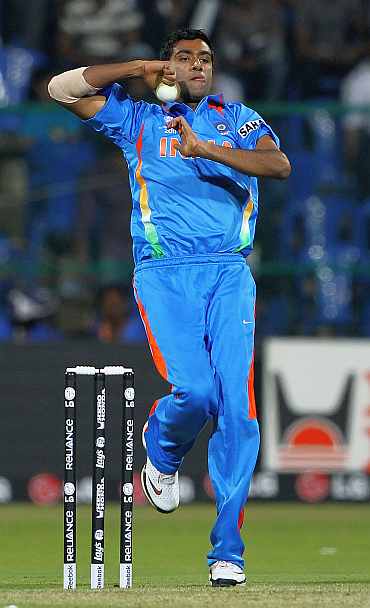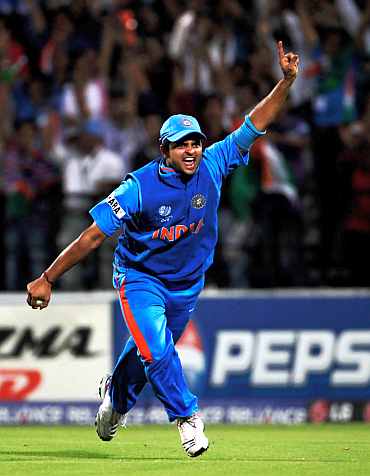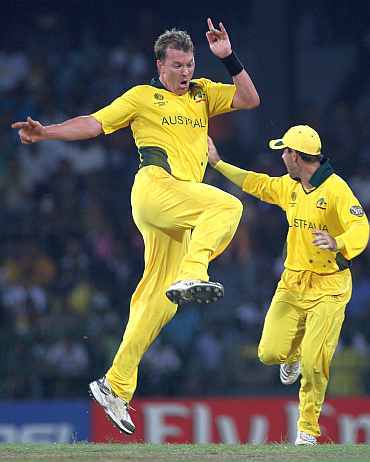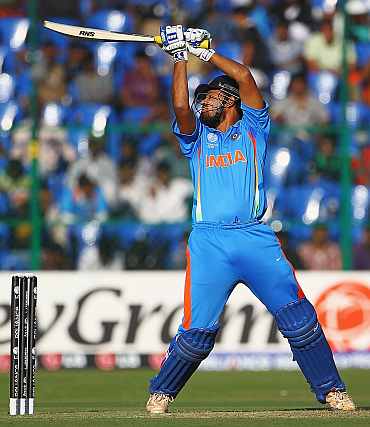
Yes! India can learn from Pakistan.
Dhoni and Co. are all set to face their modern day arch nemesis and, on the evidence of Australia's performance in Colombo, they can learn a trick or two from their traditional enemy.
Because, though this Australian side looks mediocre, there are two things the defending champions do really well -- Wake up on big match days feeling like world champions and going out and playing like one. More importantly, they don't give any second chances, and like zombies in B-grade horror movies, they keep coming at you, irrespective of the situation. That's the only way they know to play.
So India, like Pakistan did last week, have just one way to win -- to draw first blood and then bleed them with more cuts.
So, here are a few lessons from Colombo.

Ahead of their biggest group match, Shoaib Akhtar announced his retirement, in what was seen by many as an attempt to emotionally blackmail the team management into including him in the playing XI. But both Afridi and Waqar kept a calm head and went in with their best XI.
- 'Shocked to hear of Shoaib's retirement'
Unlike India, whose skipper thinks more about boosting a poor performer's confidence rather than winning the match, the Pakistan think tank did not let their hearts supersede their heads.
And with the way Afridi backed Wahab Riaz showed he was not going to give up on Plan A on the evidence of two bad overs.
The youngster came on in the 12th over, when the bowling powerplay was in effect and Ricky Ponting and Brad Haddin had played themselves in following Shane Watson's wicket. The Aussie duo started to get busy and the wet-behind-the-ears Wahab became the obvious mark.
They went after him, intimidating him by stepping down the wicket, and soon the youngster lost his bearings, spraying the ball all over the place. His two overs cost 20 runs. Afridi immediately took him out of the attack and slammed the brakes with offie Mohammed Hafeez.
But, again unlike Dhoni who in a couple of games seemed to have forgotten that a certain Ashish Nehra was on the field, he did not write off Wahab. He waited for the right opportunity, let the bowler gather his wits, and brought him back immediately after Ponting fell.
The result: Haddin, emboldened by his powerplay antics against Wahab, tried to do an encore. But the bowler had regrouped by then and was bowling straighter lines and tighter lengths around the offstump. The result: Haddin fell to a beauty on the corridor and Australia's innings never took off.

Pakistan used three quicks and three spinners against Australia.
The figures are as follows: The pacers bowled 18 overs to take 6/77 @ 4.27 runs an over. The spinners on the other hand took 3/94 in their 32 overs @ 2.9 runs an over.
While on paper it may look like the pacers destroyed Australia, the real story is slightly different and one has to look at how Afridi mixed up his bowlers.
He opened with pace and spin, and once Gul had given the breakthrough and put the Aussies on accumulation mode, he brought on spin at both ends.
Hafeez was unplayable and as the pressure kept mounting, he rehabilitated the wounded Wahab. The masterstroke was the introduction of Abdul Razzaq in the 35th over. By then Hafeez had impaled the Aussies on the lamppost.
With even Michael Clarke becoming a sitting duck, Razzaq toyed with the Aussie lower middle order, varying his pace and making the slightly petulant Colombo track look like a two-paced psycho pitch.
More importantly, Afridi's rotation also gave Gul, who had pulled up on his run up as early as his second over enough rest. He did not bowl between the 10th and 42nd overs. But when he came back, he too had the perfect platform to wickedly unleash his toe-crushing guided missiles without the burden of having to keep an eye on the run-rate.
In football, what Hafeez, Afridi and Rehman did would have been duly credited as assists, something which is as important as a goal if not more.
But that is not to say either Umar Gul or Razzaq were bad. They were very good. But they could afford to bowl attacking lines only because the spinners had pegged the Aussies back.
The lesson: Instead of solely depending on Zaheer to work singlehandedly for the breakthroughs, use the spinners to choke the suspect Aussie batsmen and bring on Zaheer or Munaf in short bursts. Not only will they be far more effective that way, they are -- Munaf especially -- bound to enjoy and revel in bowling attacking lines. And it will pay.
Also, the match will be played at Motera, Ahmedabad. The Indians would do well to look at the scorecard of the Australia v Zimbabwe match there. Zimbabwe bowled 38 overs of spin, as Ray Price and Prosper Utseya spectacularly kept Watson and Haddin in check, before some late hitting and Zimbabwe's lack of big match temperament took the Aussies to 260+.

There is a mandatory question-answer in Dhoni's pressers that goes like this: Q: What do you think of our fielding? A: We know we are bad, but it is not going to improve drastically in this tournament.
Contrast this with what Waqar said after the Australia match. "It's going to get better. We took our catches and we stopped the boundaries. We must give credit to the fielding. It makes a difference when you are playing against a bigger team. But we still need to improve."
Dhoni has gotten away under the cloak of honesty, with clucking hacks sympathizing that he could not lift the side's fielding. But the way to go is the Pakistan way.
There is no shame in accepting your shortcomings. But there is no harm either in working on them.
In the early part of the Australian innnings, every misfield earned the choicest gaalis from Afridi. The chastised fielder would then chase the next ball hit his way like his family's izzat depended on it -- and lip readers would certify that it indeed did. Afridi would not fail to appaud the effort. Those in his vicinity also got the added pat on their back.
As a result rickety bodies were thrown around the field with abandon, batsmen were hustled for singles, and athletic catches were taken. Misbah was among the standouts, with his swoop low and throw act from square leg getting rid of the supposedly dangerous Cameron White.
Heck, even Kamran 'Teflon' Akmal held on to whatever came his way, though one must say that in one of them -- a thick outer edge from Ponting -- the ball did all the hardwork in going and sticking in his right glove's webbing for the biggest wicket of the match.
Thus, Pakistan's fielding aided the bowlers especially Hafeez and Afridi -- to turn on the screws in the middle overs.
India, instead of shrugging that nothing can be done, have to raise their fielding. They can take a leaf out of their own Sachin Tendulkar's book. When India lost 9/29 against South Africa after Sachin's century, the master came out like he wanted to murder every ball hit his way. He sprinted, skidded, and dived, in an effort to balance every run his batsmen had failed to score.
Even a bad fielding side can improve its efforts and save at least 10-15 runs if not the mandatory 30-40 that good sides do. Elementary school maths is enough to understand that saving even 10 is better than conceding anything.

Australian skipper Ricky Ponting uses his three-pronged pace attack to intimidate and hustle opponents. True, Brett Lee, Mitchell Johnson and Shaun Tait can truly skittle out any side for two digits (and can even come back and knock off those runs themselves).
But if a batsman is willing to be patient and weather some blows, they also have their weaknesses. Tait is highly erratic (even his skipper uses him only in two over bursts), Johnson depends on the pitch and conditions to look really dangerous and Lee is plagued by fitness issues.
In this aspect, India have to look at the 25-year-old Asad Shafiq, who playing in only his 14th match, batted like he was Younis Khan, Mohammed Yousuf, and Inzaman rolled into one.
Though his 46 off 81 does not make for great reading on the scorecard, it was vital for the kind of courage he showed against these fast men and played the anchor protecting his teammates, twice.
When Lee removed the openers cheaply in his first spell, he ensured that there was no top order collapse by his calmness against pace. As the experienced Younis Khan joined him, he even ventured into the aggressive zone occasionally. Then the match see-sawed again as Lee removed both Younis and Misbah off consecutive balls.
The volatile Umar Akmal joined Shafiq, who brilliantly played the sedate foil to Akmal's pyrotechnics.
In the end, Shafiq was the glue that held the Pakistan run chase. Similarly, at least one Indian batsman has to take the onus of facing up Australia's pace trio and let the team the luxury of batting around him.

After Shafiq's fall, Afridi walked in with the swagger of a millionaire entering a casino and soon sauntered off like one bad day at the tables would not make any difference to his balance sheet.
Pakistan were some distance away and at the crease were Umar Akmal and Abdul Razzaq, both of whom can match their captain shot-for-shot in both the daredevilry and stupidity stakes.
Thankfully for Pakistan, they both eschewed their knack to manufacture thrills, and were determined to see their team through instead.
Especially Akmal, who in Shafiq's company was intent on hitting Mitchell Johnson to Kandy, transformed into the matured partner as he tapped the ball around and turned the strike to Razzaq.
The two whittled down the target and saw Pakistan home without further incident.
Come now to India's late order 'performances'. Performances, because they have indeed been theatrical. 5/11, 7/50, and 9/29 read great when they are bowling figures but are shocking when they come from the world's greatest and most fearsome batting order.
Luckily for India, the West Indies imploded too and the suicidal England contrived to gift India one point. Even South Africa only just about laboured to a win.
But let Dhoni and his men not get carried away by these results, for if they implode against Australia, rest assured there will be no comebacks.